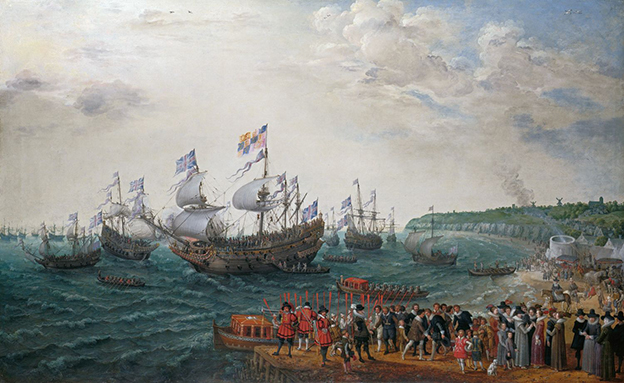
Samuel Pepys was partial to Margate ale. On 7 May 1660 he was in Deal on board Edward Mountagu’s ship the Naseby, waiting to cross over and fetch back Charles II from the Hague.
This morning Captain Cuttance sent me 12 bottles of Margate ale. Three of them I drank presently with some friends in the coach … After I was in bed Mr. Sheply and W. Howe came and sat in my cabin, where I gave them three bottles of Margate ale, and sat laughing and very merry, till almost one o’clock in the morning, and so good night.
There were other metropolitan admirers. Charles’s secretary of state Joseph Williamson liked to receive presents of Margate ale; they were sent to him at Whitehall by one of his informants at Deal, the notary Richard Watts, for favours done or hoped for. In 1679 the philosopher John Locke listed drinks made in England: ‘beer and ale, strong and small; those of most note that are to be sold are Lambeth ale, Margate ale, and Derby ale’.
Elsewhere in the Restoration world, a naval chaplain and diarist called Henry Teonge, who had a keen interest in food and drink, went to sea to escape his creditors. He was discouraged by the austere diet and absence of English ale or beer on long voyages. However, among notable meals he recorded was dinner on the king’s birthday in May 1678, with the ship at anchor off Harwich: ‘we are fain to make shift with an excellent salad and eggs, a fillet of veal roasted, a grand dish of mackerel, and a large lobster – so hard is our fare at sea: and all washed down with good Margate ale, March beer, and, last of all, a good bowl of punch.’
These fans were not the first. The earliest – and the most beguiling – celebration of ale from Margate that I can find is a poem by Robert Herrick, ‘A Hymne, to the Lares’:
It was, and still my care is,
To worship ye, the Lares,
With crowns of greenest parsley,
And Garlic chives not scarcely:
For favours here to warme me,
And not by fire to harme me.
For gladding so my hearth here,
With inoffensive mirth here;
That while the Wassaile Bowle here
With North-down Ale doth troule here,
No sillable doth fall here,
To marre the mirth at all here.
For which, O Chimney-keepers !
(I dare not call ye Sweepers)
So long as I am able
To keep a countrey-table,
Great be my fare, or small cheere,
I’le eat and drink up all here.
The poem first appeared in 1648. A few years on, during England’s brief experiment in being a republic, a bunch of literary wits produced a pamphlet of verses teasing William Davenant for his plodding and interminable Gondibert. One begins ‘Thy verses feet to run so fast | And thine alas in fetters plac’t’, and ends with a couplet identifying the medium that sustains their deathless efforts:
These colours that they nere may faile,
Were laid in Sack and Northdown Ale.
John Donne the younger (the poet’s son) got to hear about this intoxicating session. In a letter to a friend, he enclosed some verses ‘made in iest’ about Davenant, sent to him by ‘by my goode Lord Lumley in a dosen of bottles’ of Northdown ale and sack.
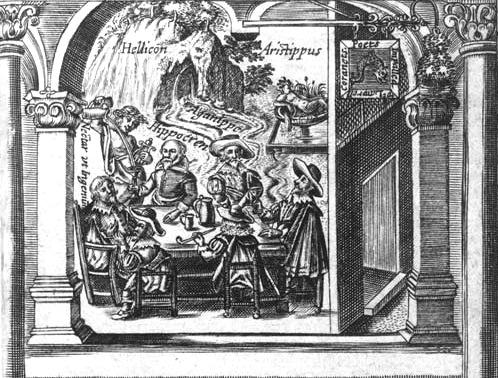
What was it like, Margate or Northdown ale, which were the same thing? Potent, evidently. The diarist John Evelyn didn’t admit to actually drinking it, but noted in his diary on 19 May 1672: ‘Went to Margate … This town much consists of brewers of a certain heady ale, and they deal much in malt, etc.’ Later, Margate’s early 18th-century historian John Lewis, curate at St John in Thanet, gives a further clue:
About 40 Years ago one — Prince of this place drove a great Trade here in brewing a particular Sort of Ale, which from its being first brewed at a place called North-down in this Parish went by the name of North-down Ale, and afterwards was called Mergate Ale. But whether its owing to the Art of brewing this liquor the dying with Inventor of it, or the humour of the Gentry and People altering to the liking the Pale North Country Ale better, the present brewers vend little or none of what they call by the name of Mergate-Ale, which is a great disadvantage to their Trade.
The brewer was probably John Prince who died in 1687, and Lewis thinks his ale was relatively dark. But Northdown ale was famous before Prince’s time, and there was certainly a malting operation up on the cliff above Margate by 1615, around the time the scene at the top of this post was painted. The view of Margate is recognisable and not a generic landscape: a small settlement in a gap in the cliffs, and a few houses climbing up the hill towards Northdown (in another version of this painting the cliffs are whiter). There could be a malthouse or brewhouse behind the plume of smoke, but there’s nothing conclusive about it. On the other hand the enormous lime kiln from which the smoke rises, built on the shore more or less where Turner Contemporary now sits, clearly appealed to Willaerts. Lewis doesn’t mention it, so presumably it was gone by 1723, although the long list of charges he records for lading or unlading goods at Margate pier includes lime, along with malt, beer and ale.
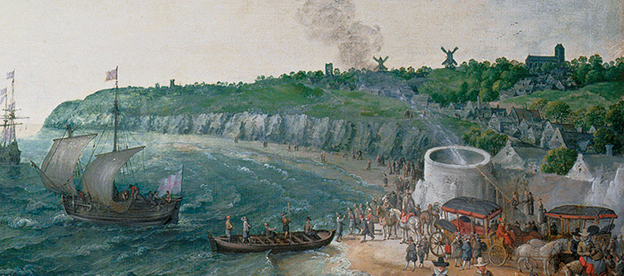
In November 1615 Richard Lee, a maltster, acquired premises at Margate from William Parker which included a malthouse or brewhouse [brasiatorum] together with other buildings and land, about three acres in all; it was the Northdown site which was to be occupied much later by Cobb’s brewery. When Lee’s son Daniel sold it in 1663 to Dame Mabel Finch, a Canterbury widow, it was as three messuages, occupied by Richard May, a brewer who had land and a brewhouse, and Rowntree Cockaine who had a malthouse. Ten years later the site was in the hands of William Petken, himself a brewer, and it remained in his family until Francis Cobb acquired it in 1763. John Prince is not directly mentioned in the leases, but he may have been a tenant; his widow Margaret was living there in 1689. She was probably from a Walloon family in Canterbury, and she could have been a brewer herself.
An expert inventor of Margate ale is hard to pin down. We might get a better idea of what the ale was like by looking at how it was made, although the available evidence is from the following century when it had gone out of fashion. Lewis in 1723 describes the decline of a Margate industry:
Malting is another branch of the trade of this place, which was formerly so large that there were about 40 Malt-houses in this Parish. But this trade is now gone much to decay; tho’ certainly here might be made the best Malt in England, the Barly which grows here being so very good, and the land naturally so kind for it. The Malt, it seems, here made having formerly been very coarse for the Use of the Distillers, it has so much lost its credit, that the present Maltsters find little encouragement to make their Malt fine for a London Market where they are almost sure to be out sold by the Hartfordshire and North-Country Malt-men, whose Malt bears a better name.
And about the farmers he is scathing:
This harvesting their Barley seems to be the worst part of their Husbandry. Because they commonly cut it too green, and let it lie too long in the swathe upon the ground. By which means the clevel or grain is shrank or lean, and has less flour in it, and very often is overheated in the Mow, or what the inhabitants call Tass-burnt, which hinders its working, and spoils its making good Malt.
Was the ale hopped? According to Lewis, local farmers got a good price in London for their grain but had trouble getting farmworkers, because so many of them went to sea or to work in the hop-gardens, although another writer remarked that near the coast ‘the winds are too boisterous for hops’. Margate ale was much more than a local brew, popular in London by the early 1600s, and it may well have included hops to help it keep.
Why build a brewery on top of the cliff? Here it gets interesting. An obvious reason is the need for power from a windmill to grind malt and draw up water. Another possibility relates to the cliffs themselves, which are tunnelled with caves dug out of the chalk. There is a suggestion that the caves were once used for malting: there are similarities with the warrens of sandstone caves beneath the city of Nottingham. A 1641 account of the Nottingham caves states that some tradesmen use them:
‘for making Malt having in them Wells and Cisterns for steeping of Barley in these they will make Malt as kindly in the Heat of Summer, as above Ground in the best Time of Winter by Reason whereof there is great Abundance made in this Town, which they vend in Lancashire, Cheshire, Shropshire, Staffordshire and the Peak of Derbyshire’.
The author of a recent archaeological report on the Margate caves believes malting in the caves is ruled out by the absence of fire-pits. However, malting is a two-stage process: soaking and sprouting the barley, then drying it. The first requires moisture and an even temperature, the second gentle heat. So although underground malt-kilns can probably be ruled out, use of galleries in the caves as germination platforms makes sense: it would allow year-round production for the London market.
The report concludes that the caves were originally a chalk-mine, which to a non-archaeologist seems odd – why dig a shaft and haul the chalk up it when you could cut an open pit, or simply go down to the shore and cut chalk out of the cliff? Along that coast are several ‘gates’ – sloping trackways that were cut through the cliff down to the beach, for the purpose of bringing up gravel, seaweed, fish or anything else that was there.
The same report suggests that two large ovoid pits within the complex, accessed from above, were most likely used as ice-wells, and dates the original excavation of the caves to the late 17th or early 18th centuries. The more poetic idea, of barley quietly swelling in cool chalk caves to make Herrick’s favoured ale, might just be true. However, the brewery deeds make no mention of the caves until 1738 when ‘two large vaults’ are listed, and again in 1763 when a much fuller survey seems to have been done, right down to gutters and watercourses, and the two large vaults appear again along with two cellars. Lewis the curate has nothing to say about the caves either, although they were presumably there in his time. It could be that in earlier deeds underground structures were regarded as part of the unspecified ‘appurtenances’.
In Connubii Flores Herrick has a malting metaphor, ‘The softest Fire makes the sweetest Mault’. The fuel used in the kiln might impart off-flavours to the malt – straw and sea-coal would impart the least taste – and Lewis tells us how it was done in Thanet: ‘The wheat stubble that is left is either mown for the use of the Malt-men to dry their Malt : or else raked off the Ground by a Horse-rake, in order to fit the land for barley &c’.
A more likely use for the caves throughout their existence than ice-wells, I think, is as caves in the French sense – cellars, though not for wine. Our 1641 source on the Nottingham caves mentions this: ‘They serve for keeping Beer and Ale in summer, where you shall have it as cold in June and July as above ground in December and January.’ There is something else to consider here too: bottles.
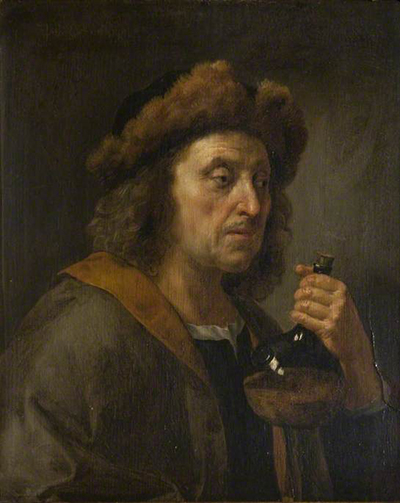
Whenever Watts the Deal notary sent Margate ale to secretary Williamson in Whitehall it was by the cask, carried up the river on a Margate hoy (a hoy can be seen flying a flag of St George at the stern in the Embarkation detail above). Pepys, on the other hand, seems always to have had it in bottles, even in Deal. He called it Northdown or Margate ale interchangeably, so the names don’t appear to signify different brews (unlike like draught and bottled Guinness, for example). Donne’s Northdown ale in the early 1650s came to him in bottles. Davenant and his tormentors were members of a London drinking club calling itself the Order of the Fancy, whose circle included Sir John Denham, Sir John Suckling, Philip Massinger, Sir Edward Conway, Herrick, Donne, the Kentish navy officer Sir John Mennes (who could have introduced Pepys to this particular ale), and Sir Kenelm Digby. The fashion for Northdown ale was perhaps launched in their furious drinking sessions.
The polymath Digby had wide scientific interests which he pursued in his own laboratory. One of his more practical inventions was a new kind of bottle-glass, tough enough to contain secondary fermentation. Fizz was important – there is a suggestion back in 1602 of dubious methods used to achieve it:
… the abuse committed by such as sell bottle ale, who to make it fly up to the top of the house at the first opening do put gunpowder into the bottles while the ale is new. Then by stopping it close, make the people beleeve it is the strength of the ale, when being truly sifted it is nothing indeed but the strength of the gunpowder that worketh the effect, to the great heart-burning of the parties that drinke the same.
Digby developed his bottle-glass in about 1632, and later described how to encourage fermentation in the bottle:
When small Ale hath wrought sufficiently, draw into bottles; but first put into every bottle twelve good raisins of the Sun split and stoned; Then stop up the bottle close, and set it in sand (gravel) or a cold dry Cellar. After a while this will drink exceeding quick and pleasant. Likewise take six Wheat-corns, and bruise them, and put into a bottle of Ale; it will make it exceeding quick and stronger.
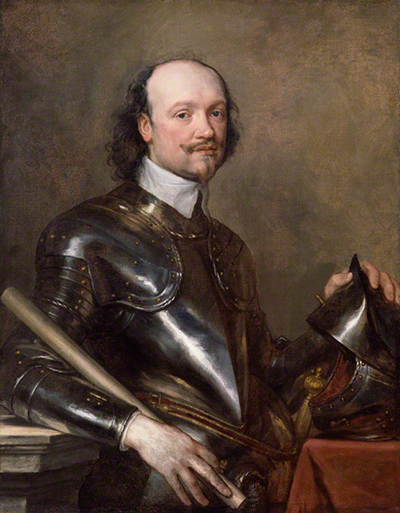
Where Margate ale was bottled is not clear. Stocks of bottles from the St Mary Overy glasshouse in Southwark could have been brought down to Margate on the hoys (quart bottles £6 for 30 dozen in 1672). But bottles were reused, and it seems more likely that the ale went to London in barrels or casks – that is how ale shipments were charged at Margate pier in 1723. The bottled ale Pepys had from Captain Cuttance in Deal was probably from naval stores. The strength of the ale that fuelled Denham and the rest of them in the 1640s and 50s might well have resulted from secondary fermentation in bottles designed by Digby, but that is speculation.
The brewery on the cliff at Margate was a substantial operation. In the first lease to be drawn up after the Restoration, in 1663, the premises are described thus: a messuage with barn, stable, garden, yard and pasture close, altogether about 3 acres; another messuage with malthouse, outhouses and yards; and a third with brewhouse, outhouses and yards. In 1734 the site was insured for £500. It seems safe to suppose that the caves under the cliff, with their cool and even climate, were intended and used by the brewery for storing ale in cask, perhaps also for fermenting, all year round.
Needless to say, this is not the whole truth about Margate ale – just what I’ve found in contemporary sources. Pepys seems to have gone off it quite fast. On New Year’s Day 1661 he gave a family breakfast party: ‘I had for them a barrel of oysters, a dish of neat’s tongues, and a dish of anchovies, wine of all sorts, and Northdown ale. We were very merry till about eleven o’clock, and then they went away.’ After that date he reports drinking Lambeth ale, China ale, Cock ale (the recipe involved boiling a cock), but never Margate ale again.
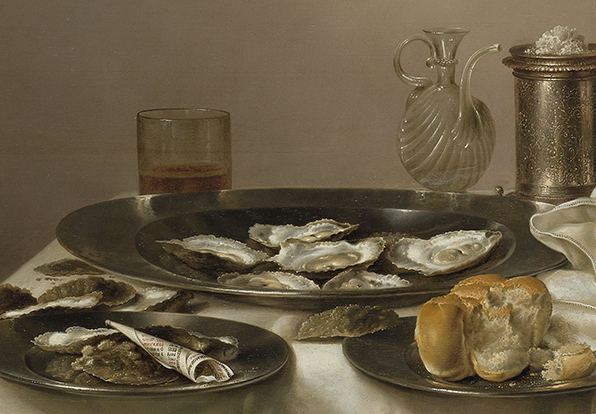
Sources
- John Locke’s Journal for 1679, quoted in H. R. Fox Bourne, The life of John Locke, vol.1, 1876, p. 426.
- G. E. Manwaring, ed., The diary of Henry Teonge, Chaplain on board H.M.’s Ships Assistance, Bristol, and Royal Oak, 1675–1679, 1927, p. 208.
- Robert Herrick, ‘A Hymne, to the Lares’, Hesperides, first edn 1648, p. 276.
- Certain Verses Written By severall of the Authors Friends; to be Reprinted with the Second Edition of Gondibert, 1653, pp. 8–9.
- John Donne to Edward Conway, 1652, quoted in Daniel Starza Smith, ‘John Donne and the Conway Papers: a biographical and bibliographical study of poetry and patronage in the Seventeenth Century’, thesis, 2011, pp. 76–77. http://discovery.ucl.ac.uk/1336209/1/1336209_Vol_1.pdf
- John Lewis, The history and antiquities ecclesiastical and civil of the Isle of Tenet, 1st edn, 1723
- The 1615 indenture for the Northdown premises is the earliest document to have survived among the papers of the Cobb Brewery, which occupied the site from 1767 [Kent History and Archive Centre, Maidstone, EK-U1453/T2/Bdl C].
- Boisterous Thanet winds are noted in A Description of the Isle of Thanet, and particularly of the town of Margate, 1765.
- ‘Copy of a manuscript account of Nottingham. Written by an anonymous author the year before the Civil War broke out’, in Transactions of the Thoroton Society, 2, 1898, pp.40–41. Similarities between Nottingham and Margate caves have been noted by members of Nottingham Historical Arts Society.
- Archaeological report by R F LeGear: ‘Margate Caves, Cliftonville’, Kent Archaeological Society, 2009.
- Malting processes are described in Karl Hagen, ‘The Economics of Medieval English Brewing’, 1995–, at http://polysyllabic.com/?q=medieval/brewing.
- The Order of the Fancy is discussed in Timothy Raylor, Cavaliers, clubs and literary culture, 1994.
- Gunpowder in ale: ‘Greene’s ghost haunting conicatchers’, 1602, in Edmund Gosse, ed., The complete works of Samuel Rowlands, 1598–1628, vol. 1, 1880.
- Digby’s 1677 recipe book published in Anne McDonell, ed., The Closet of Sir Kenelm Digby Knight Opened, 1910.
- Francis Buckley, Old London Glasshouses, repr. Society of Glass Technology 2006, p.181.
Links
There is more on Deal and secretary Joseph Williamson in this post.
A comprehensive resource on Margate history, particularly good for maps and illustrations, is at www.margatelocalhistory.co.uk
Nottingham history has an excellent site at www.nottshistory.org.uk
Great post! You should alert the people at the Intoxicants Project. They’d love all this wonderful detail: http://www.intoxicantsproject.org/
Thanks! Glad you like it, and I shall.